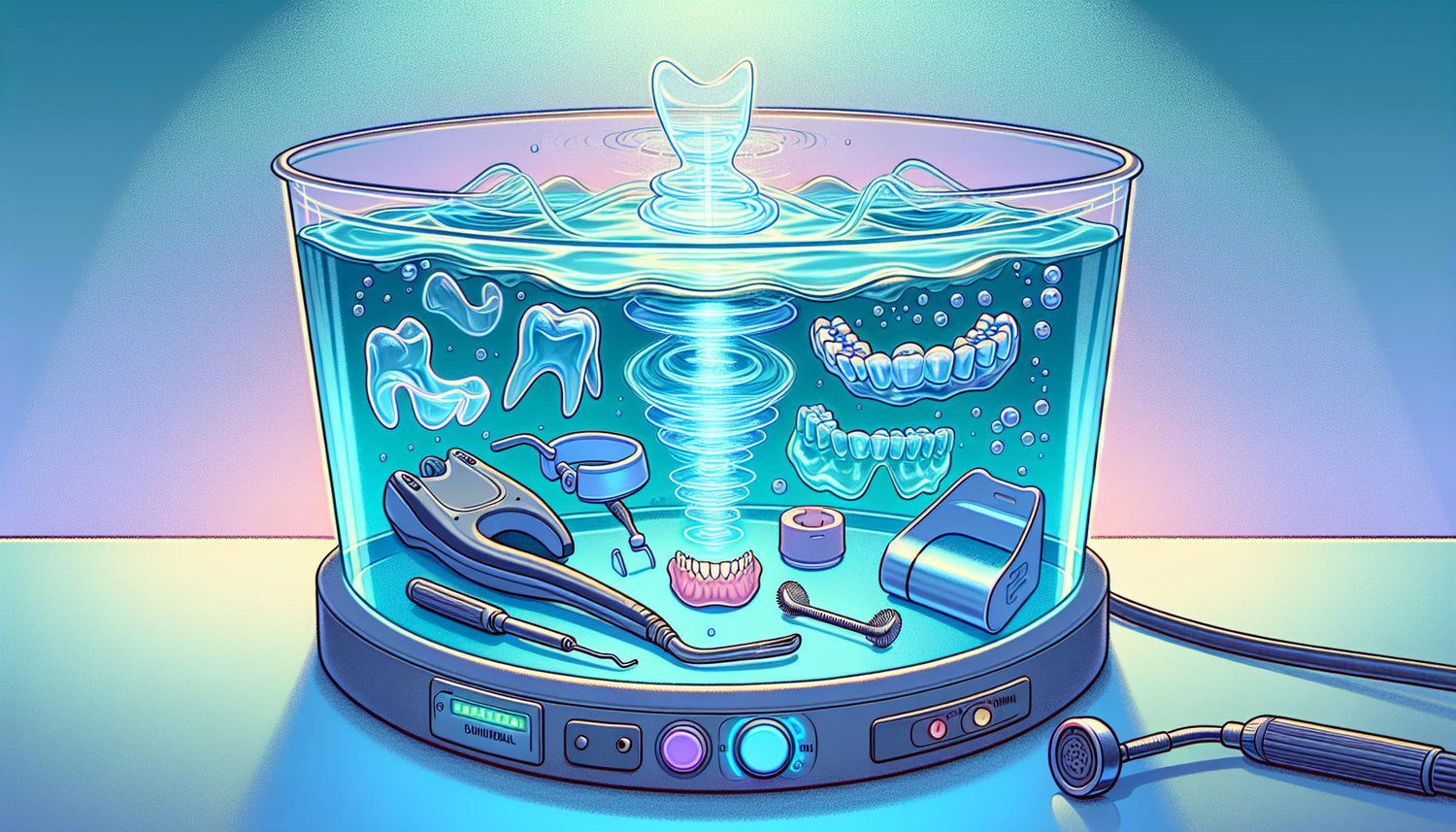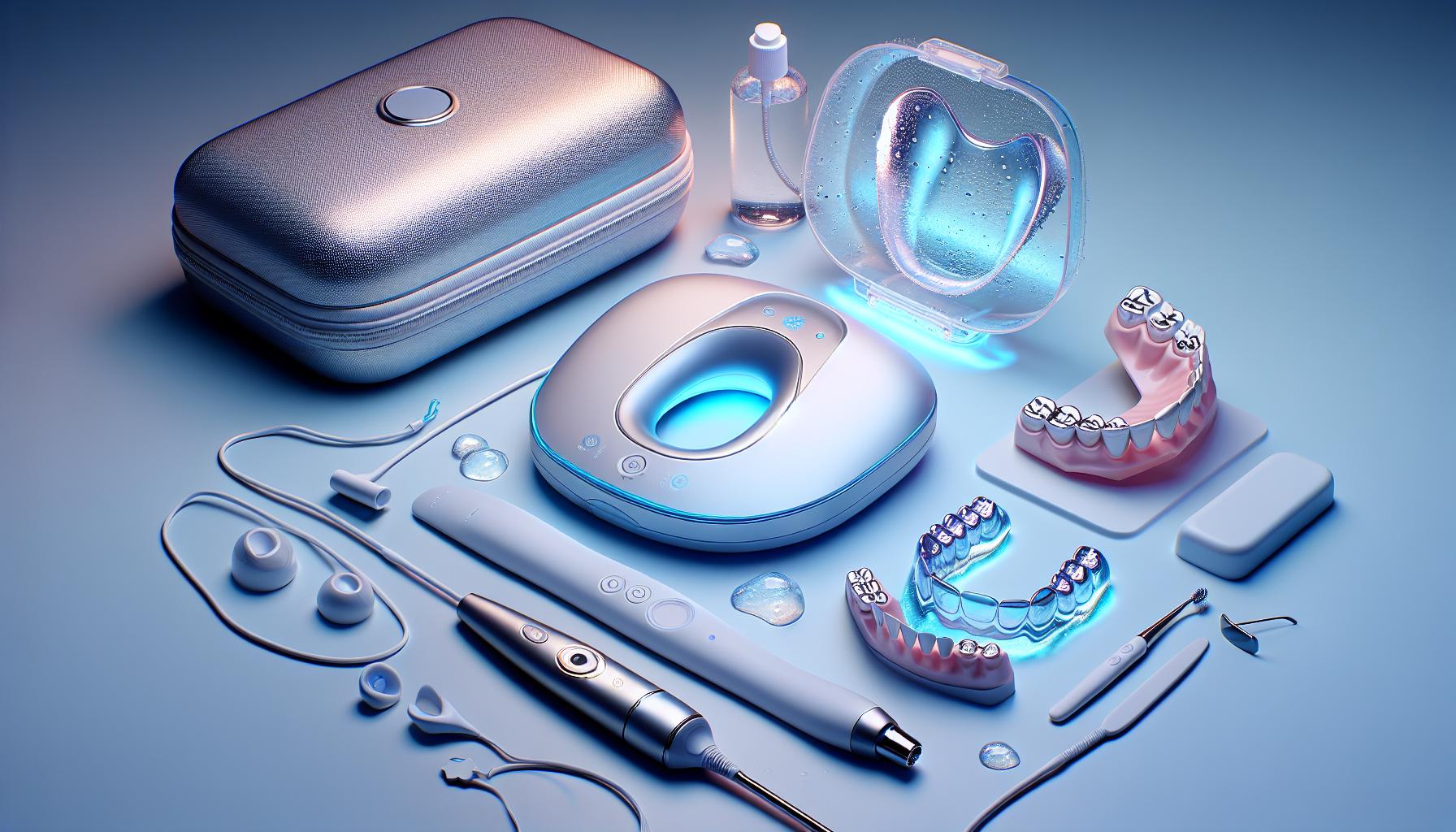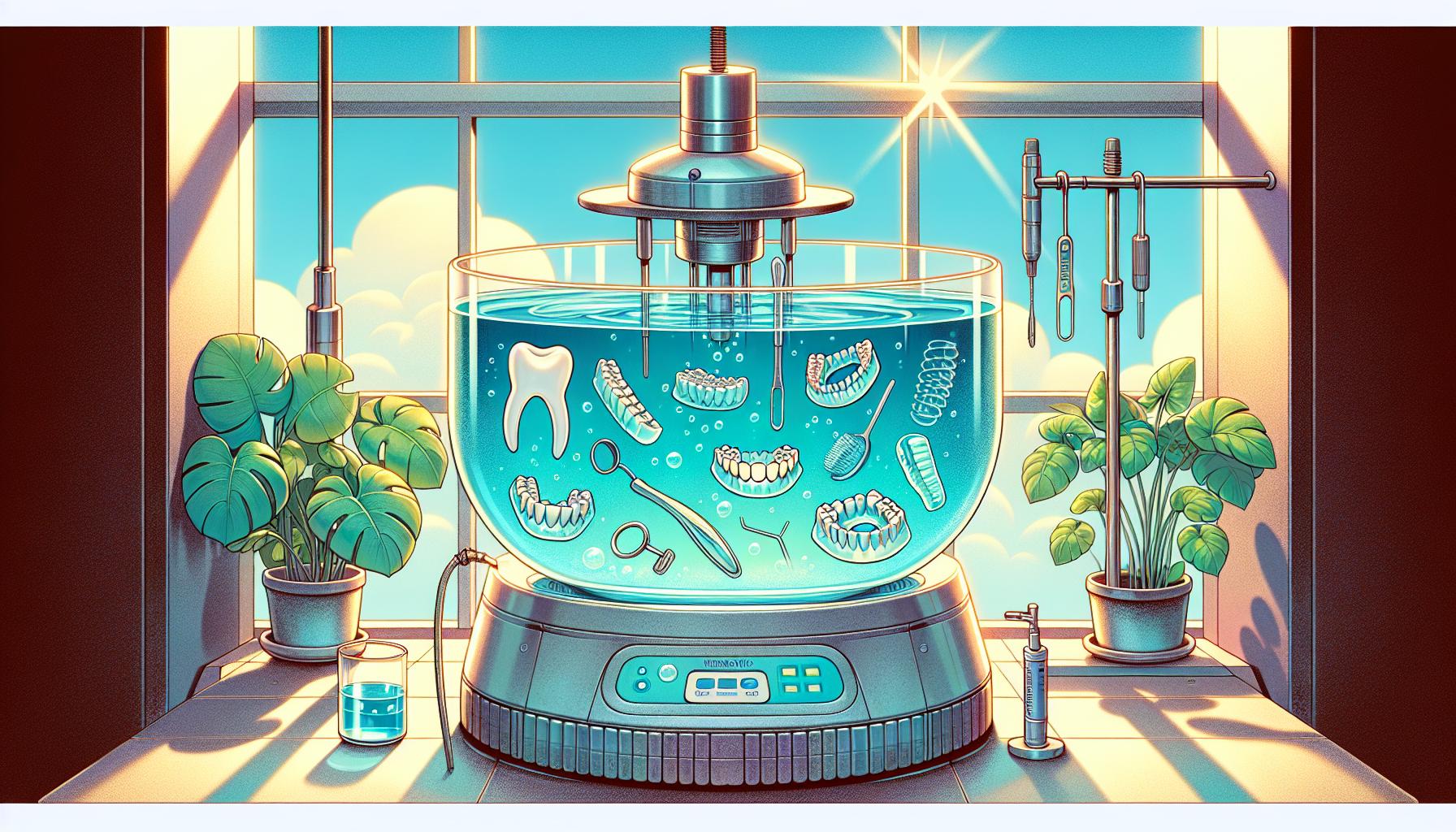The Science Behind Ultrasonic Cleaning
Ultrasonic cleaning technology harnesses high-frequency sound waves to create millions of microscopic bubbles in a cleaning solution. When these bubbles implode, they generate tiny shock waves and microjets that dislodge plaque, bacteria, and debris from dental appliances. This process, often referred to as cavitation, ensures that contaminants are removed from even the smallest crevices of your aligners, retainers, or dentures.
The Process of Cavitation
At the heart of the technology lies cavitation. When an ultrasonic retainer cleaner emits high-frequency sound waves into the cleaning solution, the energy causes the liquid molecules to vibrate intensely. This vibration forms small bubbles that rapidly expand and contract. When the bubbles collapse, they create microscopic shock waves. These waves have enough force to break down surface contaminants without damaging the material of your dental appliance. This explains why an ultra sonic cleaner for retainer is so popular among users who value both effectiveness and safety.
Temperature and Cleaning Efficiency
Ultrasonic cleaning devices often operate in a controlled environment where the temperature of the cleaning solution is optimized for maximum efficiency. The elevated temperature supports the chemical cleaning agents in dissolving and removing stubborn contaminants. Unlike other cleaning techniques that may use abrasive materials, ultrasonic cleaning relies solely on the energy of sound waves and safe cleaning solutions, making it ideal for delicate dental appliances.
Inside the Ultrasonic Cleaning Tank: A Step-by-Step Breakdown
Understanding what goes on inside a retainer cleaner machine can help demystify the ultrasonic cleaning process and provide you with confidence in your appliance maintenance routine. Here is a detailed breakdown of what happens inside the tank:
1. Preparation and Loading
Before you start the cleaning cycle, it’s important to properly prepare your dental appliances. Remove any visible debris by rinsing your aligners or denture with a gentle rinse. Once pre-cleaned, place your appliance into the cleaning basket or directly into the ultrasonic retainer cleaner tank. Ensure that your appliance is fully submerged in the cleaning solution, which is usually a safe, specialized liquid recommended by the device manufacturer.
2. Activation of the Device
After the appliance is loaded, you activate the cleaning cycle. The device’s transducers then convert electrical energy into high-frequency sound waves that permeate the cleaning solution. At this point, the retainer cleaner machine is hard at work, creating thousands of high-energy cavitation bubbles.
3. Formation of Cavitation Bubbles
The transducers inside the cleaning tank send ultrasonic waves uniformly throughout the liquid. These waves cause rapid vibrations that lead to the formation of cavitation bubbles throughout the medium. It is these bubbles that drive the cleaning process by forming and collapsing near the surface of your dental appliance. The collapsing bubbles create a powerful yet gentle scrubbing action, ensuring all buildup is removed without direct contact.
4. Implosion and Dislodgment of Contaminants
Once the bubbles reach a certain size, they implode with considerable force. This implosion, or cavitation, generates intense microjets that effectively dislodge any plaque, food particles, or bacterial biofilm from your aligners or dentures. Even in areas that are difficult to reach with manual cleaning methods, the ultrasonic action is capable of removing microscopic debris, ensuring your dental appliances are thoroughly cleaned.
5. Rinsing and Final Cleansing
Many ultrasonic cleaning devices incorporate a final rinse phase where the appliance is rinsed with the cleaning solution. This rinsing phase further enhances the overall cleanliness by dispersing any dislodged contaminants. For individuals using devices like the best ultrasonic retainer cleaner, this step ensures that their appliance comes out not only visibly clean but also sanitized.
The Benefits of Using an Ultrasonic Retainer Cleaner
Switching to an ultrasonic retainer cleaner can offer numerous advantages over traditional cleaning methods. Here are some key benefits:
Superior Cleaning Efficacy
Thanks to cavitation, ultrasonic cleaning provides a deeper clean than manual brushing or soaking. There is a reduced likelihood of missing hidden crevices, ensuring that your appliance is disinfected at a microscopic level. The ultrasonic invisalign cleaner, for example, is highly regarded among users who frequently battle discoloration and odors.
Time-Saving and Efficient
Ultrasonic cleaning devices work quickly. With the best retainer cleaner machine, most cleaning cycles take only a few minutes, saving users time and effort compared to more labor-intensive cleaning routines. This makes it an excellent choice for busy individuals who cannot compromise on oral hygiene.
Non-Abrasive and Gentle on Your Appliance
Unlike abrasive cleaning methods that may damage aligners or dentures over time, ultrasonic cleaning is gentle yet highly effective. The action of the high-frequency sound waves means there is no physical scrubbing, which minimizes wear and prolongs the lifespan of your dental appliances.
Versatile Application
Many ultrasonic cleaning devices are designed to be multifunctional. Whether you need an ultra sonic cleaner for retainer, cleaning dentures with an ultrasonic cleaner, or even maintaining other dental appliances, these machines offer a versatile solution. This multi-use capability often makes them the preferred choice for maintaining dental hygiene across different appliances.
Selecting the Best Ultrasonic Retainer Cleaner Machine
When it comes to choosing the best ultrasonic retainer cleaner, there are several factors to consider to ensure that you receive a reliable and effective appliance:
1. Performance and Cleaning Power
Look for a device that delivers consistent high-frequency waves with adjustable settings, if possible. A high-quality retainer cleaner machine should offer a range of cleaning cycles tailored to the needs of different dental appliances. The ultrasonic invisalign cleaner should be capable of reaching even the smallest crevices in your aligners for thorough cleaning.
2. Capacity and Versatility
Make sure the cleaning device has enough capacity to accommodate your dental appliances comfortably. Some models come with specialized baskets or holders designed for different shapes and sizes. For those who require cleaning dentures with an ultrasonic cleaner, select a machine that can efficiently accommodate larger or more complex items.
3. Ease of Use and Maintenance
An easy-to-use control panel with clear instructions is key when selecting an ultrasonic cleaning device. Furthermore, the design should allow for straightforward cleaning and maintenance of the machine itself. Choosing one of the best retainer cleaner machines on the market can simplify your oral hygiene routine with user-friendly features.
4. Safety and Reliability
Ensure that the device has several safety features, such as automatic shut-off and heat protection. A device that has been rigorously tested and approved by health agencies is always a preferable choice. Reading user reviews and expert opinions can also help in identifying which ultrasonic retainer cleaner models have proven to be reliable over time.
5. Price and Warranty
There is a wide range of options available, from budget-friendly models to high-end machines. While cost is an important consideration, always factor in the warranty and customer support offered by the manufacturer. Investing in one of the best ultrasonic retainer cleaners might represent a higher initial outlay, but it often pays dividends in terms of longevity and cleaning performance.
How Ultrasonic Cleaners Are Revolutionizing Oral Hygiene
Over the past few years, ultrasonic cleaning technology has evolved from its industrial origins to become an indispensable tool for personal dental care. Here are a few ways in which these devices are pushing the boundaries of oral hygiene:
Enhanced Bacterial Control
The high-frequency cavitation process not only removes debris but also disrupts bacterial biofilms on your dental appliances. This reduction in bacterial load is essential in preventing infections and maintaining a healthy oral environment. By using an ultrasonic retainer cleaner, you can significantly reduce the risk of bacterial colonization in your aligners or dentures.
Reduced Risk of Cross-Contamination
Since cleaning devices like the best ultrasonic retainer cleaner require minimal manual intervention, there is a reduced chance of cross-contamination. This is particularly beneficial in households with multiple users or for individuals who maintain several types of dental appliances. The hands-off approach provided by a retainer cleaner machine minimizes direct contact with contaminants.
Consistency and Reliability
Manual cleaning methods often lead to variable results depending on the technique used and the thoroughness of the cleaning process. Ultrasonic cleaning, however, provides a consistent, repeatable cleaning cycle every time. This reliability is especially appealing for individuals who require regular and precise cleaning, such as those using an ultrasonic invisalign cleaner.
Applicability to Various Materials
Ultrasonic cleaning is not limited to a single material type. Whether your dental appliance is made from plastic, metal, or a combination of materials, the ultrasonic process adapts to provide the necessary cleaning without causing damage. This versatility is what makes devices effective for cleaning dentures with an ultrasonic cleaner and for preserving the integrity of orthodontic devices.
Expert Tips for Maximizing the Benefits of Your Ultrasonic Cleaner
To get the most out of your ultrasonic cleaning device, follow these expert tips:
Pre-Clean Thoroughly
While ultrasonic cleaning is highly effective, it performs best when the appliance is free from heavy debris. Rinse your aligners, retainers, or dentures prior to placing them in the device. This ensures that the cavitation process can focus on bacteria and plaque rather than dislodging large particles.
Follow Manufacturer Guidelines
Always adhere to the cleaning solution recommendations and the operating instructions provided by your device’s manufacturer. The proper concentration of cleaning agents and adherence to the recommended cycle duration are essential for optimal performance. Furthermore, if you are using a specific ultrasonic invisalign cleaner, check that the manufacturer’s guidelines are followed meticulously to preserve the integrity of your aligners.
Regular Maintenance of the Device
Just as important as cleaning your dental appliance is the maintenance of your cleaning device itself. Regularly inspect and clean the tank of your retainer cleaner machine to remove any residual buildup. An unclean cleaning solution can compromise the efficiency of the cavitation process and may lead to contamination over time.
Experiment with Cycle Settings
If your device offers multiple cycle settings, don't hesitate to experiment to find the optimum cleaning time for your specific appliance. Some retainers or dentures might benefit from a longer cycle, especially if there is significant buildup. Over time, you will develop an understanding of the settings that work best for your unique needs.
Store Appliances Safely Post-Cleaning
After the cleaning cycle, ensure that your dental appliance is adequately dried and stored properly to prevent any moisture-related issues. Proper storage will help maintain the hygiene achieved by your cleaning cycle and protect against potential bacterial growth.
The Future of Dental Appliance Cleaning
The integration of ultrasonic technology in dental care has marked a significant evolution in the way we maintain oral hygiene. Ongoing developments promise even greater improvements in cleaning efficiency and device automation.
Smart Integration
The next generation of ultrasonic cleaning devices is expected to incorporate smart technology. This could include connectivity with mobile apps, automated cleaning cycles based on appliance type, and more precise monitoring of the cleaning process. Imagine a retainer cleaner machine that adjusts its cycle based on the specific optical sensors detecting the level of contamination on your aligners. This level of automation will ensure optimal cleaning while reducing manual effort.
Eco-Friendly Solutions
Sustainability is a growing concern in consumer electronics. Innovators in the ultrasonic cleaning market are now developing eco-friendly designs that minimize energy consumption and use biodegradable cleaning solutions. In the near future, choosing the best ultrasonic retainer cleaner might also mean supporting environmentally sustainable practices.
Customizable Cleaning Programs
As manufacturers continue to refine their designs, customizable cleaning programs will allow users to set their own parameters. Whether you need a gentle cycle for sensitive materials or a more intense cleaning process for heavily soiled dental appliances, the flexibility offered by future devices will be a game-changer for oral hygiene routines.
The Versatility of Ultrasonic Cleaning Beyond Aligners
While this article has focused significantly on cleaning aligners, retainers, and dentures with ultrasonic cleaning devices, it’s important to highlight that the technology is very versatile. Here are a few other applications where ultrasonic cleaning has found a beneficial role:
Jewelry and Eyewear
Ultrasonic cleaners are widely used for cleaning jewelry and eyewear. The same cavitation technology effectively removes oils and dirt from delicate items without the need for harsh chemicals. This makes ultrasonic cleaners a preferred choice for users looking for a safe and efficient cleaning method.
Dental Instruments
In professional dental practices, ultrasonic cleaning is a standard procedure for sterilizing dental instruments. The comprehensive cleaning action ensures that no minute particles remain which could harbor bacteria or viruses.
Household Items
From small electronic components to kitchen utensils, ultrasonic cleaning machines provide a convenient solution for deep cleaning several household items. The technology’s precision allows for the effective cleaning of delicate items that might be damaged by traditional scrubbing methods.
Addressing Common Concerns
As with any technology, potential users of ultrasonic cleaning devices might have questions or concerns. Here are answers to some common queries that surface when considering devices such as the ultrasonic retainer cleaner:
Is Ultrasonic Cleaning Safe for All Dental Materials?
Yes, ultrasonic cleaning is generally safe for most dental appliances, including aligners, retainers, and dentures. The process is designed to be gentle on materials while being effective on contaminants. However, it is always recommended to read the manufacturer’s guidelines for both your appliance and your cleaning machine to avoid any compatibility issues.
How Often Should I Clean My Dental Appliances?
The frequency of cleaning depends on your usage and the type of appliance. For individuals who wear their aligners or retainers for extended periods daily, a daily cleaning cycle using a high-quality ultrasonic invisalign cleaner is advisable. Similarly, those cleaning dentures with ultrasonic cleaner should maintain a regular cleaning schedule to prevent the buildup of biofilm and bacteria.
Can I Use My Ultrasonic Cleaner for Other Items?
Absolutely. Many users have found that their retainer cleaner machine can be utilized for other cleaning tasks around the house. However, it is important to ensure that the items being cleaned are compatible with ultrasonic cleaning and that any chemicals or solutions used do not damage the items or the device.
Conclusion
Ultrasonic cleaning technology has revolutionized the way we maintain the hygiene of our dental appliances. By harnessing the power of cavitation, these devices offer a thorough and efficient cleaning routine that is far superior to traditional manual methods. From understanding the formation and implosion of cavitation bubbles to exploring the myriad benefits of using an ultra sonic cleaner for retainer, the science behind these machines is as fascinating as it is effective.
Choosing the best retainer cleaner machine involves assessing performance, capacity, ease-of-use, safety, and overall reliability. Whether your focus is on an ultrasonic invisalign cleaner for regular maintenance or a versatile device for cleaning dentures with an ultrasonic cleaner, these machines provide a consistent and convenient cleaning solution that is both smart and sustainable.
As technology continues to evolve, the future of ultrasonic cleaning in dental care looks bright, with smarter devices, eco-friendly designs, and customizable cleaning cycles on the horizon. By understanding what actually happens inside the tank during an ultrasonic cleaning cycle, you can better appreciate the science and innovation that goes into maintaining your oral hygiene. Embrace the technology, invest in the best ultrasonic retainer cleaner that suits your needs, and enjoy the peace of mind that comes with knowing your dental appliances are thoroughly sanitized and maintained.
For anyone looking for a modern, effective cleaning solution, transitioning to an ultrasonic cleaning device can make all the difference. With deep cleaning, enhanced bacterial control, and a gentle touch for sensitive materials, these devices truly offer a revolutionary step forward in personal dental care. Whether you’re using an ultra sonic cleaner for retainer, investing in the best retainer cleaner machine, or exploring methods for cleaning dentures with ultrasonic cleaner, the benefits are clear—and the technology continues to advance for even greater outcomes.
By incorporating an ultrasonic cleaning device into your daily dental care regimen, you not only extend the life of your dental appliances but also promote better oral health. It’s a simple, effective, and scientifically proven method that leaves little to chance. Discover the benefits of ultrasonic cleaning today, and see for yourself why so many users rely on these advanced machines for a consistently superior clean.
Invest in the best ultrasonic retainer cleaner that meets your specific needs, and enjoy a simpler, more efficient cleaning process that keeps your aligners and retainers in immaculate condition. The science is sound, the technology is proven, and the results speak for themselves—experience the future of dental appliance maintenance with ultrasonic cleaning.


